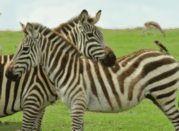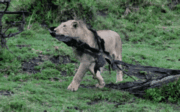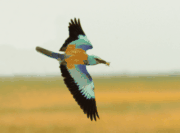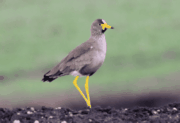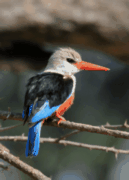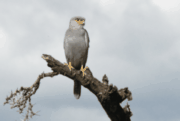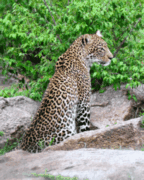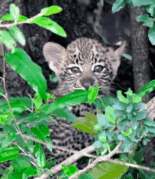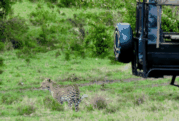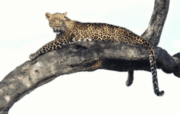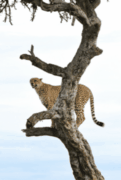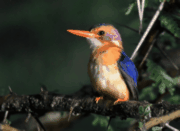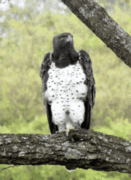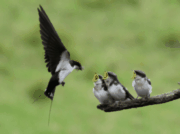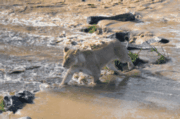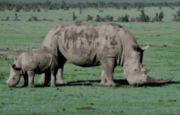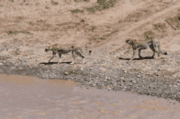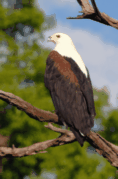|
Mike Mockler Kenya |
Kenya Escorted Tour, March 2023 I’ve sung the praises of Kenya’s private conservancies countless times so it will come as no surprise that I was very keen to lead this tour which would visit two Masai Mara Conservancies as well as Ol Pejeta Conservancy in the north. However, I was concerned about the continuing drought in many parts of Kenya. When Pat and I had visited in November 2022, the rains had started and things were looking promising but back in the UK I heard that the rains had petered out after our visit and I feared that the March tour would be dry, dusty and hot. As it turned out, the rains began in earnest shortly before we arrived back in Kenya and, thankfully, there was no shortage of rain during this tour. The drive from the bush airstrip to our first camp provided a taste of wonderful things to come. The plains were green with very fresh grass and there was a rich variety of mammals, many with new-born young, and a dazzling array of birds. The rain was already working its magic! Giraffes and zebras seemed to be everywhere along with herds of buffalos, impalas, elands and Thomson’s gazelles. It all looked promising but small clouds of dust stirred up by our Land Cruiser’s tyres were evidence that the plains still needed much more rain to compensate for many months of drought. On our first morning, we came across three young cheetahs who were scanning the area for potential prey. They had recently split from their mother and were now having to hunt for themselves. A daunting task for them but apparently they had hunted successfully on several occasions already. We also found a handsome male cheetah resting close to camp. That evening, as I was escorted to the mess tent in the dark, my askari shone his torch into the bush to show me a cheetah walking almost alongside us; it was the same male we had seen earlier. Later during the night, lions walked past our tents roaring to each other. We really were in the heart of wild Africa. Wonderful! We spent some time with the local lion pride and enjoyed a young male’s hilariously clumsy attempts to cross a river without getting his feet wet. Later, when we caught up with other members of the pride the sub-adults were obviously bored and started to play with a fallen dead tree, tearing off strips of bark. The young male who had amused us earlier crossing the river now managed to wrap a shredded strip of bark several metres long around his head and shoulders. He strutted around proudly with what he seemed to consider was a form of decoration or a badge of honour. Birds were seen in staggering numbers. There were migrants heading north to Europe including Eurasian Rollers, European Bee-eaters, Common Cuckoos, Great Spotted Cuckoos, Yellow Wagtails, various Wheatear species, Barn Swallows, Montagu’s Harriers and Pallid Harriers. It was thrilling to witness migration in action on this scale. Resident birds were everywhere. Some, like the ever-raucous and permanently furious Crowned Lapwings, were impossible to miss. A Pied Kingfisher used a road bridge as his favourite fishing perch, reluctant to move away even when vehicles were just inches away. Malachite Kingfisher and African Pygmy Kingfisher also posed obligingly for photographs, as did a beautiful Grey Kestrel. Back at camp, a Black-headed Heron strolled nonchalantly ahead of us on the path to our tents and two clients had a Eurasian Roller roosting each night in a tree beside their tent. . A leopard mother, known to have a very small cub, was discovered resting on a rocky riverbank. The cub was nowhere to be seen but we hoped we might see it later. In fact, two days later we found the mother and her tiny cub deep inside a thicket. It was difficult to see the cub well but we managed to do so with binoculars. Having moved on to our next camp, we discovered another female leopard whom I have seen many times since 2014 when she hid her first litter of tiny milky-eyed cubs in dense vegetation within our camp. This time, we found her on the first day reclining in an open grassy area not far from camp, almost as if she was waiting for us. She walked right past our vehicle, strolled across the valley floor and set off to climb the rocky escarpment. On reaching the top, she paused to scan the landscape, standing majestically on the skyline, I wondered what was going through her mind. Was she looking for her adolescent son who we knew was not far away? Or was she thinking that the time had come for her to leave him as he was now able to fend for himself? Finally, her considerable experience kicked in. She looked over her shoulder at the approaching storm-clouds and opted to find cover. She re-traced her steps to where we had found her, passing us once again, before she disappeared into a dense croton thicket near one of her favourite trees. Resting in our comfortable tent, we watched as some elephants strode across the valley. I never tire of watching elephants. On one game-drive, we spent time with a breeding herd, which included a very small calf that repeatedly chased away Cattle Egrets, flapping his little ears in mock charge. What fun he was having! He also experimented using his trunk to suck up water from a pool but then was at a loss as to what he should do with the water! We eventually found the female leopard’s young son, reclining elegantly on the branch of a tree. He had taken his warthog kill up into the tree but now decided to take his prize elsewhere. The tree provided only partial shade so he came down from the tree with the warthog in his mouth and strolled casually past us and on to some bushes where he settled down in good shade. Later, we saw him walking along a branch of a large riverside tree, apparently contemplating a prodigious leap over the river to the opposite bank. All agreed that he wouldn’t take such a risk but suddenly he astonished everyone when he launched himself into space, landing safely on the other side of the river. It seemed he had done this before. We were familiar with two male cheetahs known as “the two boys”. However, on this occasion, they were behaving strangely, repeatedly making two types of call, the familiar bird-like contact call and an intense purring sound which I had previously heard when male cheetahs were trying to corral a female with cubs to check if she was coming into oestrus. By the following day, the “two boys” had become separated and we found one of them who appeared to be extremely distressed, walking continuously while persistently using the two calls we had heard earlier. He was clearly desperate to find his brother and leapt up into a tree to scan the surrounding plains and project his calls as far as possible. Very interesting behaviour, especially as cheetahs are not adapted for climbing trees. On one game-drive, we found another cheetah who was the mother of the three young cheetahs we had seen 8 days earlier, having just split from their mother. We also encountered a tiny giraffe, only a few hours old and it was a delight to watch as it tried to control its gangly legs. We saw an impressive gathering of over 60 elephants on the plains near camp and then we discovered three massive bulls just outside camp, one of which had magnificent tusks. All three were very relaxed, feeding quietly on the fresh, juicy grass within touching distance of our vehicle. Setting off with yet another magnificent sunrise, we found the local lion pride that had killed a big male buffalo in the night. There were several cubs there, including two small ones that were being introduced to the pride. The older cubs were using the dead buffalo as a plaything on which they could practise their hunting and killing skills. As the lions were feeding on the buffalo, an elephant family arrived. The big matriarch trumpeted a warning to the lions, making it clear who was the boss, before passing by with her young family. The playful cubs were still providing endless entertainment while an inexperienced mother’s trials and tribulations with her badly-behaved cubs were a source of great amusement to us. Nearby were two mating lions and, a little further away, there was a big lioness with three tiny cubs hidden in a croton thicket. For some clients these were the smallest lion cubs they had ever seen. One afternoon, we noticed scores of European Bee-eaters swirling around and calling, looking for somewhere to roost for the night on their long journey north. Then a flock of 200+ White Storks, also migrating to Europe, arrived. Initially they foraged on the plain before flying up to perch on flat-topped acacias, transforming them into decorated Christmas trees. A treat back in camp was when three Wire-tailed Swallow chicks fledged from their nest which was just above the entrance to our tent. Thereafter, we were able to watch the parents bringing food for their ever-hungry offspring. OPTIONAL EXTENSION TO LAIKIPIA The Ol Pejeta Conservancy offers many things that are different from the Mara Conservancies. Rare Jackson’s hartebeest, reticulated giraffe, Beisa oryx, Grevy’s zebra along with black rhinoceros and southern white rhinoceros were just some of the species that we saw. At our new camp, the water-hole was not full but contained enough water for waterbirds including African Spoonbills, Red-billed Teal, Blacksmith Lapwings and ubiquitous Egyptian Geese. Groups of elephants also came to drink from time to time. Our first southern white rhinos were at very close range, including a huge bull known as Jomo (named after Jomo Kenyatta) near a scenic pool. We hoped he might come to drink from the pool or even wallow in the mud but we had to be satisfied with him posing for photographs nearby. Further sightings of white and black rhinos with young provided more excellent photo-opportunities. We also spent time with two young cheetah siblings wanting to cross a river as they searched for their mother. They searched and searched but the flowing river still obstructed their progress; it was sad to watch them looking in vain for a suitable crossing. The following day we heard that they finally found a way to cross the river and were reunited with their mother. Mornings in Ol Pejeta were glorious, with sparkling views of Mount Kenya. We photographed more reticulated giraffes at dawn, silhouetted against the mountain. Night-drives were productive for clients, with excellent sightings of lesser bush baby (lesser galago), white-tailed mongooses, steenbok, bush duiker and African Grass Owl. Sadly they narrowly missed an aardvark sighting. On our last day, the snowy summit of Mount Kenya was clearly visible in dazzling sunshine as five southern white rhinos and a black rhino mother with a calf posed perfectly for photographs. As we crossed over the river, an African Fish-eagle landed in a tall riverside tree silhouetted against the setting sun, threw its head back and gave that iconic, haunting call. It was the perfect end to our final afternoon game-drive and a truly memorable safari.
|
|


